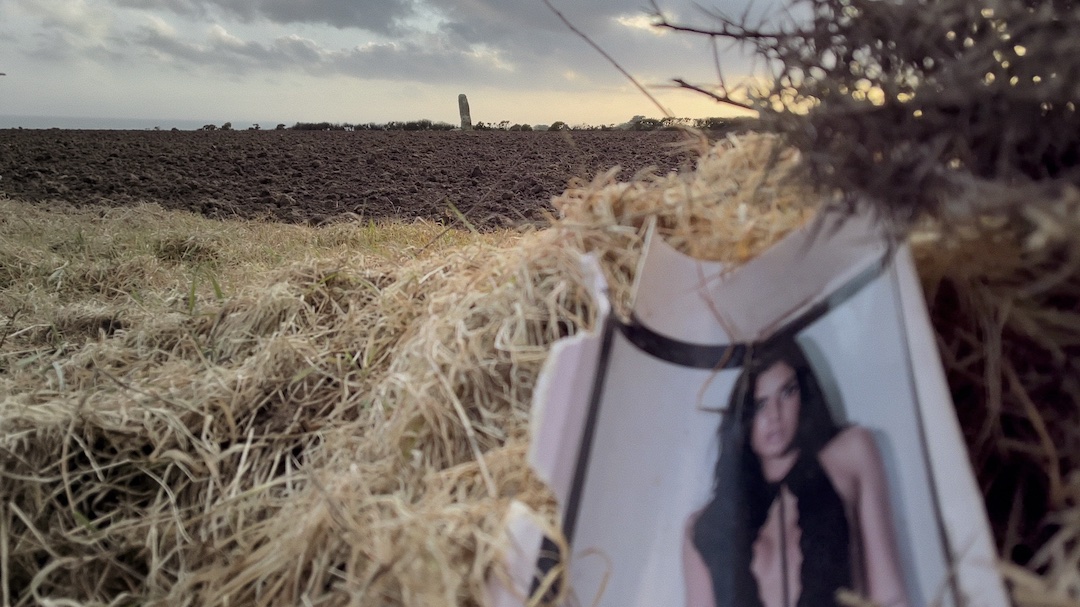A shot of a dead field mouse sets the tone for this sobering “slow cinema” documentary, narrator-director Christopher Morris’s response, simultaneously aghast and philosophical, to the looming environmental catastrophe.
Rather than contemplate the decimation of the Amazon rain forests or the melting of the polar ice caps, Morris decided to spend a year filming the barley field that surrounds the 4,000-year-old Boscawen-Rôs East menhir, or standing stone, four miles north-east of Land’s End in Cornwall.
According to the late earth mysteries writer John Michell, the so-called Longstone and its fellow menhir were uprooted early in the 20th century; whereas Boscawen-Rôs East was restored to the middle of the field, Boscawen-Rôs West’s stump was built into the rocks of a typical Cornish hedge.
Between winter solstice 2020 and winter solstice 2021, Morris trained his camera on and around the former lichen-covered stone, though he also looked south to the English Channel. Passing container ships and a lorry on a distant road are the film’s only signs of contemporary human activity, aside from the wrappers and packaging that blow into the field.
Scorning the bipeds whose pollutants and burning of fossil fuels eliminated 69 per cent of monitored vertebrates between 1970 and 2018 and are massacring the insect population at rates of nine percent (terrestrial species) and eleven percent (freshwater) each year, Morris observes birds, cows, slugs, snails, an earthworm, and bugs going about their business. Nocturnally foraging mice, their eyes points of light in the night vision images, dart around or flinch when they spot the camera or its operator. A badger shows up, reminding me of two badgers I saw in rural Hertfordshire earlier this month, their carcasses shoved to the sides of the roads on which they were killed.
Morris marvels that he can’t name one winged insect with hair-thin limbs he shows dining on a leaf for several minutes; what seems uneventful to the viewer was existential for that creature in that moment in its brief life. The scene is part of the film’s effective scheme of parochialisation. As the field is a microcosm of the earth, so an insect’s work as a pollinator, decomposer, and feeder of wildlife is crucial to the ecosystem, the food web, life on earth. Watching it is humbling.
A Year in a Field’s glacial pacing can’t help but emphasise the beauty of what is being lost – Morris’s photography is sublime – but the beauty is inherent in nature’s communal organisation, nothing to do with aesthetics (not to minimise the loveliness of the pink, white, and yellow wildflowers glimpsed on screen). Underscored by stringed instrument music that veers between plaintive and grating, perhaps intentionally, the slowness is agitating because Morris contrasts it with the speed at which we’re imperilling the planet according to Einstein’s Doomsday Clock.
 Following the atomic bombings of Hiroshima and Nagasaki at the end of World War Two, the clock was initially set at seven minutes to midnight in 1947, midnight being the time of a hypothetical global catastrophe. By the pandemic year of 2021, the clock read one minute 40 seconds to midnight; as of now, it’s 90 seconds to midnight, the war in Ukraine adding to the environmental toll taken by the climate crisis.
Following the atomic bombings of Hiroshima and Nagasaki at the end of World War Two, the clock was initially set at seven minutes to midnight in 1947, midnight being the time of a hypothetical global catastrophe. By the pandemic year of 2021, the clock read one minute 40 seconds to midnight; as of now, it’s 90 seconds to midnight, the war in Ukraine adding to the environmental toll taken by the climate crisis.
Among the trash Morris found and photographed in the field was a Snickers wrapper and a packet (pictured above) for an item of lingerie seductively modelled by a young woman in the label photo. Building his metaphor, Morris notes that the undies in question (an Ann Summers “luxe bodysuit”) were manufactured from vegetation-based carbon turned into synthetic fibres in China and travelled 6000 miles in a container before the bag came to adorn a Cornish barley field.
He says that the world’s 100,000 cargo ships – which are powered by toxic tarry bunker fuel, illegal for use on land but not at sea – emit a billion tons of greenhouse gases every year: a seductive statistic if ever there was one. Of 100 billion items of clothing made annually, Morris adds, 60 billion are discarded within a year. Perhaps not to overwhelm us, he doesn’t quantify the damage done by the airplane contrails he shows streaking the sky above Cornwall in heat-trapping clouds.
The Longstone might inspire awe for its longevity and Celtic-Druidic mystique, but as A Year in a Field draws to a close Morris queries what it represents. Boscawen-Rôs means “the place of the elder on the heath,” but elder trees no longer stand there. At the start of the Bronze Age, the elders were cut down and burned as part of the tin-smelting process and the local rivers polluted.
“Maybe the Longstone is a fuck-you to nature,” Morris concludes ruefully, “a symbol of human dominance [made] by a civilisation that sidestepped nature to build a world of make-believe.” Not the least of the documentary’s strengths is the realisation that such a world is as sustainable as an unnamed insect, fragility personified, getting its fill on a leaf.















Add comment